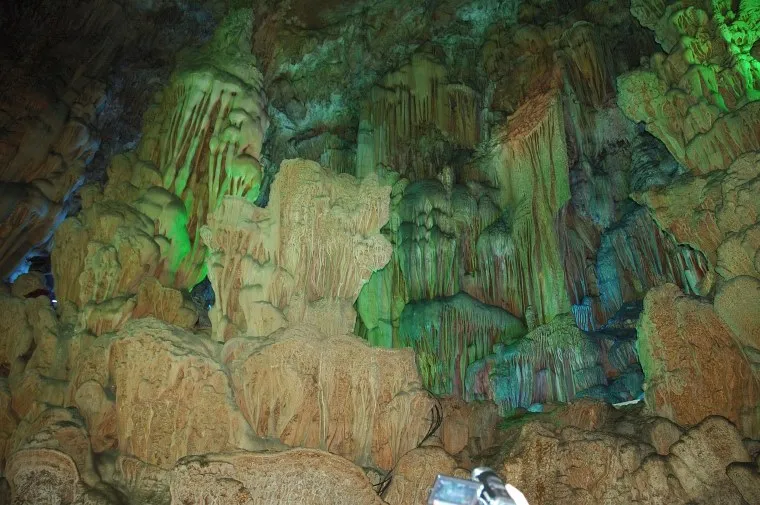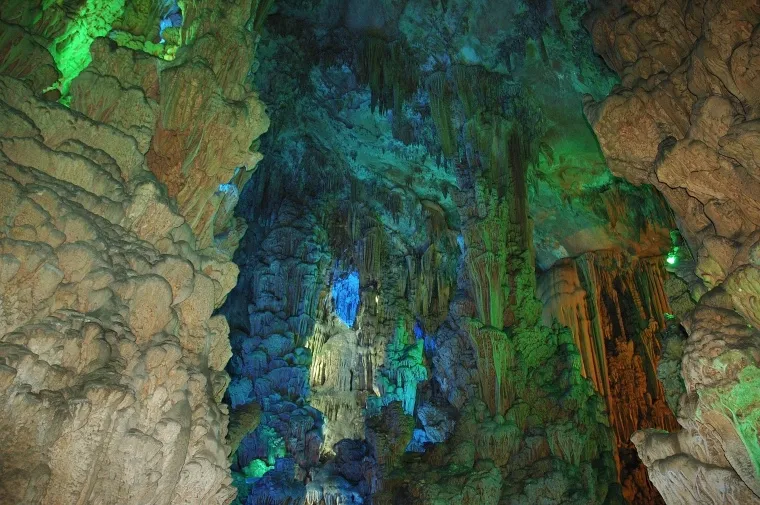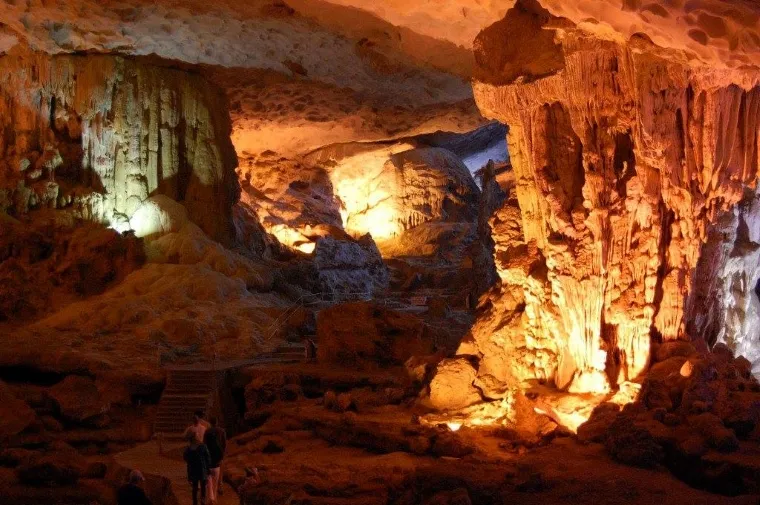Dau Go Cave: Exploring the Wooden Stakes Wonder of Ha Long Bay
Nestled within the breathtaking limestone karsts of Vietnam's UNESCO World Heritage Site, Ha Long Bay, Dau Go Cave (Hang Đầu Gỗ) stands as a magnificent natural wonder with profound historical significance. This spectacular grotto, whose name translates to "Wooden Stakes Cave," combines awe-inspiring geological formations with a compelling connection to Vietnam's storied past. For travelers seeking to experience the perfect blend of natural beauty and cultural heritage, Dau Go Cave offers an unforgettable adventure into one of Ha Long Bay's most treasured attractions.
A Natural Masterpiece in Ha Long Bay
Dau Go Cave is nestled on Dau Go Island in Ha Long Bay, just 3 km from Tuan Chau Island and about 6 km from Bai Chay Tourist Area. It sits 27 meters above sea level and lies only 300 meters from Thien Cung Cave, making it easy to explore both in one trip. Surrounded by emerald waters and majestic limestone karsts, the scenic journey to the cave is an experience in itself.

Dau Go Cave is a stunning limestone grotto easily accessible within Ha Long Bay, offering dramatic scenery and a scenic boat journey - Photo Source: Pixabay
Covering around 5,000 square meters, Dau Go Cave welcomes visitors with a wide entrance—17 meters across and 12 meters high. Inside, the cave unfolds in three chambers. The first is bright with natural light, the second reveals dramatic rock formations, and the third holds a freshwater well. Each chamber offers a unique experience, gradually leading explorers deeper into this fascinating geological marvel.
Natural Features and Geological Significance
Breathtaking Stalactites and Stalagmites
Dau Go Cave is most renowned for its extraordinary stalactites and stalagmites, formed over millions of years through slow mineral deposition. These natural sculptures create a stunning subterranean landscape, rich in texture and form.
What makes the cave especially captivating is the diversity of shapes and structures—many of which resemble animals such as lions, elephants, deer, and turtles, as well as mythical creatures and intricate floral or castle-like forms. The way natural light enters the cave and reflects off the rock surfaces creates a dreamlike ambiance, with shades of cream, gold, and red adding depth to the visual experience.

The cave boasts impressive geological formations and a rare blend of natural beauty and biological diversity - Photo Source: Pixabay
Rich Flora and Fauna
Unlike most limestone caves, which are typically dark and dry, Dau Go Cave supports an unusually rich ecosystem. Thanks to its large entrance and consistently high humidity, mosses, ferns, and even small woody plants thrive near and within the cave. This lush vegetation contrasts beautifully with the stone formations, bringing an added layer of color and life to the environment.
The cave is also home to various animals, including bats, spiders, crickets, and swallows, making it a rare site where visitors can witness the interaction between geological and biological worlds. This richness is also a point of comparison in Thien Canh Son Cave reviews, where visitors often note the differences in biodiversity between the two destinations.
Geological Formation and Age
Dau Go Cave was formed approximately 2 million years ago, during the same geological period as the nearby Thien Cung Cave. It is composed of karst limestone, a defining characteristic of Ha Long Bay's landscape. The bay itself has undergone a geological formation process spanning millions of years, shaped by tectonic activity and karst erosion.
Understanding the cave's ancient origins adds a profound temporal dimension to the visitor experience. When standing amidst formations that have developed over millions of years, one gains a humbling perspective on human history and the powerful geological forces that have shaped our planet.
Exploring Dau Go Cave: A Visitor's Guide
How to Get There
Accessing Dau Go Cave requires a boat journey, as it is located on an island within Ha Long Bay. Most visitors arrive as part of organized boat tours that depart from ports such as Tuan Chau or Bai Chay. The ferry terminal on Tuan Chau Island is also a departure point for independent travelers wishing to visit the cave.
Tour Route Number 1, which includes Dau Go Cave among its attractions, is the most common way to visit. Various cruise options are available, ranging from day trips to overnight excursions on traditional wooden junks or modern cruise ships.
Travelers can explore the cave via boat tours, with flexible options and seasonal tips to enhance the experience - Photo Source: Facebook Vịnh Hạ Long Quảng Ninh - Thiên Đường Cảnh Vịnh
Opening Hours and Best Time to Visit
Dau Go Cave is typically open from 7:30 AM to 5:00 PM. However, opening hours may vary by season or according to specific tour companies, so it's advisable to verify before planning your visit.
The ideal time to visit Dau Go Cave is during the dry season, from October to April, when the weather is more favorable and visibility is generally better. Morning visits often provide the benefit of smaller crowds, while afternoon light can create dramatic effects on the cave formations.
Entrance Fees and Tour Options
Entrance fees for Dau Go Cave are usually included in Ha Long Bay tour packages or sightseeing tickets. The price for Tour Route Number 1, which includes Dau Go Cave, typically ranges from 250,000 VND to 290,000 VND per person.
Additional fees may apply, such as port entrance fees (approximately 40,000 VND) and options for private boat rental (ranging from 1,600,000 VND to 2,500,000 VND for a 4-hour tour). Various tour options are available, including day trips and extended bay cruises that include a visit to Dau Go Cave.
Here's a summary of typical costs and tour options:
|
Option |
Description |
Approximate Cost (VND) |
|
Day Tour (Route 1) |
Includes Dau Go Cave, Thien Cung Cave, etc. |
250,000 - 290,000 |
|
Tuan Chau Port Fee |
Additional fee at Tuan Chau Port |
40,000 |
|
Private Boat Rental (4 hours) |
Flexible exploration |
1,600,000 - 2,500,000 |
|
Ha Long Bay Cruises |
Various duration options, typically including Dau Go Cave |
Varies |
What to Wear and Bring
For a comfortable exploration of Dau Go Cave, visitors should consider wearing:
-
Comfortable, non-slip shoes or hiking sandals (the cave floor can be slippery)
-
Lightweight, breathable clothing
-
A light jacket or sweater (the cave can be cooler than the outside temperature)
Items to bring include:
-
A camera with good low-light capabilities
-
A small bottle of water
-
Insect repellent (particularly during warmer months)
-
A small flashlight for better visibility of formations
Photography Tips
To capture the best images inside Dau Go Cave:
-
Use a tripod if possible for sharper images in low-light conditions
-
Experiment with different angles to highlight the interesting shapes of stalactites and stalagmites
-
Take advantage of the natural light near the entrance for more detailed shots
-
Include people in some photos to provide scale and perspective
-
Focus on unique formations that resemble familiar objects or creatures
Highlights and Must-See Features
The Three Chambers
Each of the three chambers in Dau Go Cave offers distinct attractions:
- First Chamber: Illuminated by natural light from the entrance, this chamber offers the best visibility and serves as an introduction to the cave's wonders. Look for the interplay of light and shadow on the rock formations near the entrance.
- Second Chamber: The most dramatic of the three sections, featuring impressive stone pillars naturally "carved" into animal and human-like shapes. Listen for the wind passing through rock crevices, creating sounds resembling drum beats for an added sensory experience.
- Third Chamber: The deepest section, notable for its freshwater well and more intimate atmosphere. The lighting here creates mysterious effects on the stone formations, offering excellent photographic opportunities.

The cave's three chambers and striking rock formations offer visual and historical wonders for visitors - Photo Source: Facebook Vịnh Hạ Long Quảng Ninh - Thiên Đường Cảnh Vịnh
Notable Rock Formations
Throughout the cave, keep an eye out for these remarkable formations:
- The Royal Court: In the second chamber, a series of stone columns appear to form what looks like an ancient royal court, with formations resembling a king, queen, and their subjects.
- Animal Kingdom: Various stalactites and stalagmites throughout the cave take the shapes of animals, including elephants, turtles, monkeys, and birds. These natural sculptures showcase nature's artistic capabilities.
- The Ancient Castle: A large formation in the second chamber resembles a medieval castle, complete with what appear to be towers and battlements.
- The Stone Waterfall: A massive formation that looks like a frozen waterfall, with rippling stone cascading from ceiling to floor.
The Freshwater Well
In the third chamber, don't miss the natural freshwater well, a geological feature that adds to the cave's mystique. According to local legends, this well never runs dry, even during the driest seasons, and its water is considered particularly pure.
Nearby Attractions and Activities
Other Caves to Explore
Near Dau Go Cave, visitors can explore several other remarkable caves:
- Thien Cung Cave (Heavenly Palace Cave): Located just 300 meters away, this cave features unique phosphorescent surfaces and distinctive formations. Its proximity makes it an easy addition to a Dau Go Cave visit.
- Sung Sot Cave (Surprise Cave): One of the largest and most impressive caves in Ha Long Bay, known for its expansive chambers and dramatic lighting.
- Me Cung Cave (Maze Cave): Considered a "natural museum" with remarkable geological features and a complex structure that gives it its name.
- Luon Cave: A water cave that can be explored by boat or kayak, offering a different style of cave experience. The Luon Cave history tells of its long-standing connection to local legends and the area’s diverse marine life.
Complement your visit with nearby caves, islands, and exciting outdoor activities around Ha Long Bay - Photo Source: Facebook Vịnh Hạ Long Quảng Ninh - Thiên Đường Cảnh Vịnh
Islands and Rock Formations
The area surrounding Dau Go Cave features numerous interesting islands and formations:
- Ti Top Island: With a beautiful beach and panoramic viewpoint accessible via 427 steps, this island offers some of the best views in Ha Long Bay.
- Cat Ba Island: The largest island in the area, featuring a national park with rich biodiversity.
- Fighting Cocks Islet (Hon Ga Choi): An iconic symbol of Ha Long Bay, featuring two rock formations resembling roosters facing each other.
- Incense Burner Islet (Hon Dinh Huong): An island shaped like a giant incense burner, famous enough to be featured on Vietnam's 200,000 VND banknote.
- Saddle Island (Hon Yen Ngua): Named for its distinctive shape resembling a horse's saddle.
Activities in the Area
Visitors to Ha Long Bay can enjoy numerous activities beyond cave exploration:
- Bay Cruising: From day trips to overnight luxury cruises, exploring the bay by boat is essential to fully appreciate its beauty.
- Kayaking: Paddle around limestone karsts and through water caves for a more intimate experience of the bay.
- Swimming: Many tours include stops at small beaches or floating platforms for swimming in the emerald waters.
- Rock Climbing: For adventure enthusiasts, some islands offer rock climbing opportunities.
- Visiting Floating Villages: Traditional fishing communities like Cua Van and Vung Vieng provide cultural insights into life on the water.
- Sun World Halong Complex: This entertainment park featuring amusement rides and a cable car provides panoramic views of the bay.
Tips for an Unforgettable Visit
Planning Your Trip
-
Book in advance: Especially during peak tourist seasons (December-February and July-August), tours to Ha Long Bay can fill up quickly.
-
Consider an overnight cruise: While day trips include Dau Go Cave, overnight cruises allow for a more relaxed pace and the chance to see the bay at sunset and sunrise.
-
Check weather forecasts: While Ha Long Bay is beautiful year-round, visibility can be affected by fog or rain, particularly from February to April.
-
Combine with other attractions: Most tours that include Dau Go Cave also visit other notable sites, maximizing your experience.
Enhancing Your Experience
-
Learn about the history: Understanding the legend of General Tran Hung Dao and the wooden stakes enhances appreciation of the cave's cultural significance.
-
Take your time: Allow at least 45-60 minutes to fully explore all three chambers of the cave.
-
Look for shapes in the formations: Part of the fun is identifying the various animals and objects represented in the natural rock formations.
-
Engage with guides: Tour guides often share interesting facts and legends that aren't included in written materials.
Responsible Tourism
-
Stay on designated paths: Venturing off marked trails can damage delicate formations and ecosystems.
-
Don't touch stalactites or stalagmites: The oils from human hands can disrupt the natural growth process that has taken millions of years.
-
Take all trash with you: Help preserve the pristine condition of this UNESCO World Heritage site.
-
Respect the cultural significance: Remember that many Vietnamese consider the cave a place of historical and spiritual importance.
Conclusion: A Natural and Historical Treasure
Dau Go Cave is a striking blend of natural wonder and cultural heritage. Its towering stalactites and stalagmites, formed over millennia, create a mesmerizing underground world, while its links to a legendary Vietnamese military victory lend it powerful historical significance.
Standing inside the cave, you’re not just admiring geology—you’re stepping into a story that spans both ancient natural forces and human triumphs. It’s this rare combination that makes Dau Go a must-visit in Ha Long Bay.
Whether you're drawn by nature, history, or simply curiosity, Dau Go Cave offers a rich, layered experience—an essential stop for anyone exploring northern Vietnam.
|
Joytime Travel Agency - Travel JOY, TIMEless Vietnam Follow us for travel tips, local insights, and exclusive offers:
|

Danish Nguyen
Danish Nguyen is a renowned travel blogger in Vietnam with over 5 years of experience sharing unique travel experiences. With a passion for exploring new places, Danish captures incredible moments and provides readers with valuable tips to discover the beauty of his homeland.




















